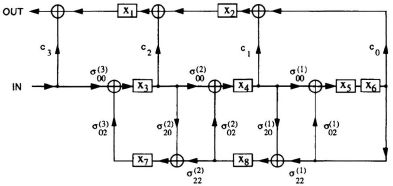12.6 DERIVATION OF SCALED-NORMALIZED LATTICE FILTER
By applying the slow-down and retiming/pipelining (SRP) transformation (see Section 11.7) with M = 2 to a 3rd-order normalized lattice filter, we obtain the filter structure in Fig. 12.17. In Fig. 12.17, each delay element is represented by xi, for i = 1 to 8, and ![]() is denoted by ci, for i = 0 to 3. From (12.74), each xi(n), for i = 3 to 8, has unit power. In terms of the state covariance matrix, Kii = 1, for i = 3 to 8, where Kii is the i-th diagonal element of K. Then, to scale the filter, we only need to compute the powers of x1(n) and x2(n), which can be computed from (11.25). In the case of the normalized lattice filter, K11 and K22 can be computed more efficiently using the orthonormality of the Schur polynomials. From Fig 12.17, the polynomial at the state x1 is given by:
is denoted by ci, for i = 0 to 3. From (12.74), each xi(n), for i = 3 to 8, has unit power. In terms of the state covariance matrix, Kii = 1, for i = 3 to 8, where Kii is the i-th diagonal element of K. Then, to scale the filter, we only need to compute the powers of x1(n) and x2(n), which can be computed from (11.25). In the case of the normalized lattice filter, K11 and K22 can be computed more efficiently using the orthonormality of the Schur polynomials. From Fig 12.17, the polynomial at the state x1 is given by:

Fig. 12.17 A 3rd-order normalized lattice filter after upsampling and retiming with M = 2.
![]()
Therefore, using the orthonormality of the Schur polynomials,

By the same way,
In general, for the summing node on the top line of module i, the power is . To have ...
Get VLSI Digital Signal Processing Systems: Design and Implementation now with the O’Reilly learning platform.
O’Reilly members experience books, live events, courses curated by job role, and more from O’Reilly and nearly 200 top publishers.

